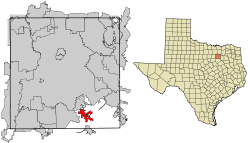Wilmer, Texas
USGenWeb >> TXGenWeb >> Dallas County >> Towns & Communities >> Wilmer, Texas
 |
|
| Latitude | 32°35′27″N |
| Longitude | 96°40′57″W |
| Elevation feet/meters |
466/142 |
| Zip Code | 75172 |
| Founded | |
| GNIS FID | 1350245 |
| TXGenWeb Site | |
| Cemeteries | |
| Library | |
| Local Genealogy Society | |
| Dallas ISD | |
| Wikipedia | |
| cityofwilmer.com | |
|
|||||||||||||||||||||||||||
The area was initially settled by Andrew K. Gray before 1850. The settlement was originally known as Prairie Valley when the Houston and Texas Central Railroad arrived in 1872. In 1884, the post office in Prairie Valley was renamed Wilmer, after A.J. Wilmer, a conductor on the Houston and Texas Central line. The population was estimated at 100 in 1890, with several stores and businesses operation in the community. That figure had risen to over 200 by the start of World War I. A fire destroyed most of Wilmer's business district on July 4, 1929. The community's shallow wells were unable to pump the adequate amount of water needed to extinguish the blaze.
Wilmer incorporated in 1945, and its first mayor, J.H. May, was elected on a platform of installing a water system. At the time of incorporation, Wilmer had 136 homes and a population of approximately 450. In 1949, a volunteer fire department was established and a fire truck was purchased. Around the same time, Wilmer and the neighboring city of Hutchins consolidated their schools. By 1960, Wilmer was home to 1,785 residents. Throughout the latter half of the twentieth century, Wilmer continued to grow, but at a much slower rate than other communities in Dallas County. With 3,393 residents as of the 2000 census, Wilmer is currently one of the smallest incorporated cities in Dallas County.
.... Read More Wikipedia ....
Lisa C. Maxwell
Wilmer is at the junction of Interstate Highway 45/U.S. Highway 75 and Cottonwood Creek, fourteen miles southeast of downtown Dallas in southeastern Dallas County. Andrew K. Gray, the holder of the original land patent arrived in the area before 1850. The community was called Prairie Valley when the Houston and Texas Central Railroad established a stop in 1872. The earliest of several dates given for the founding of Wilmer is 1876. In 1883 J. W. Johnson, a settler from Tennessee, and later the first postmaster, arrived. In 1884 the post office located in Prairie Valley was renamed Wilmer, after A. J. Wilmer, a conductor on the Houston and Texas Central, who often passed through town. By 1890 Wilmer was a thriving agricultural community raising cotton to be shipped on the Houston and Texas Central and had a population of 100, two churches, a steam mill and cotton gin, and two general stores. By the time of World War I the community had a population of over 200, three churches, White Banking Company, the Citizen's Cotton Oil Company (which did the ginning in town), a blacksmith shop, a restaurant, a livery stable, two drug stores, and two groceries. Telephone connections were available. On July 4, 1929, a fire destroyed most of the business district, including one of its two banks. Fire trucks arrived but were unable to pump enough water from Wilmer's shallow wells. After the fire much of the town was rebuilt to the east, along Highway 75. The population at the time was 250. In 1945 Wilmer was incorporated with J. H. May as the first mayor, primarily to implement a public water system. At the time of its incorporation it had 136 homes and a population of 450. By the late 1940s the community had not implemented a water system because of the enormous expense. This lack of available water gave Wilmer one of the highest fire insurance rates in the country. Wilmer and the nearby community of Hutchins combined their two school districts and built a new school halfway between the communities. The majority of the workforce, an estimated 85 percent, commuted to work in Dallas. Two manufacturers were located in Wilmer at the time, an ice factory and a cotton gin. The nineteen businesses in town hired those who did not commute to Dallas or work in agriculture raising cotton, corn, oats, and livestock in the area's fertile bottom land. In 1949 a volunteer fire department was started and a used fire truck purchased for their use. The population grew rapidly throughout the next four decades, primarily because of the town's proximity to Dallas, though its growth was much slower than most Dallas County towns. By 1990 the population was 2,479, of which 47 percent were Caucasian, 30 percent Hispanic, and 21 percent black. Wilmer had a mayor-council form of city government, its own library, churches of five denominations, and four manufacturers, including three lumber suppliers. Seven policemen and twenty volunteer fire fighters protected the community. The population reached 3,393 in 2000.
Bibliography: Dallas Morning News, August 14, 1983. Dallas Times Herald, August 8, 1948. Vertical Files, Dolph Briscoe Center for American History, University of Texas at Austin.
Handbook of Texas Online, Lisa C. Maxwell, “Wilmer, TX”




